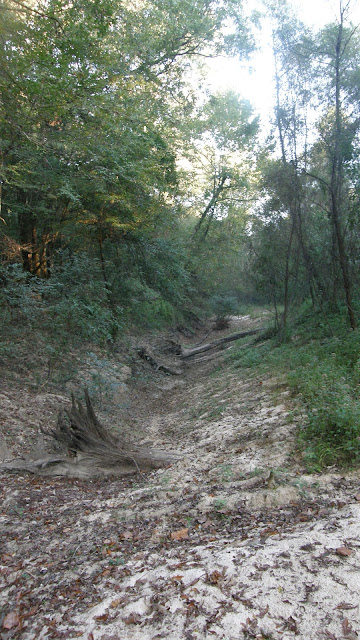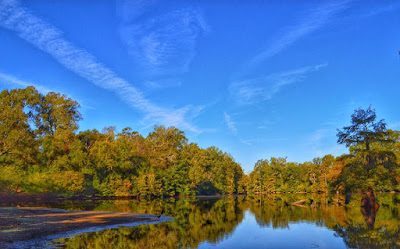IBWOH's: Brian Carlisle, Chris Carlisle.
Summary: Encouraged by our findings in the Otter Pond area in the far north of the Pascagoula Wildlife Management Area (WMA), my brother Brian and I decided to follow up with a trip to Booger Hole Slough, a small lake a little over a mile (as the crow flies) to the north of Otter Pond, and which effectively marks the northern limit of the WMA. We were obliged to take a different road into the WMA from the highway, in order to put our kayaks into the Pascagoula River a few hundred yards below what looked to be a channel off the river; we planned to follow the channel inland as far as we could, then strike out overland for Booger Hole Slough, which lay nearby.
The morning dawned fair and cool; the thermometer in Brian's truck read 61 degrees (Fahrenheit). There were no clouds. The access road first plunged through young pine plantation on private land, before winding through middle-aged mixed cypress/bottomland hardwood forest in the WMA. Long, narrow Cochran Dead River, an oxbow being slowly but surely consumed by the forest, lay partially hidden by cypresses and mist and the predawn gloom off to our right. We arrived at the landing (really just a wide, flat, grassy space along the riverbank) with the dawn.
Summary: Encouraged by our findings in the Otter Pond area in the far north of the Pascagoula Wildlife Management Area (WMA), my brother Brian and I decided to follow up with a trip to Booger Hole Slough, a small lake a little over a mile (as the crow flies) to the north of Otter Pond, and which effectively marks the northern limit of the WMA. We were obliged to take a different road into the WMA from the highway, in order to put our kayaks into the Pascagoula River a few hundred yards below what looked to be a channel off the river; we planned to follow the channel inland as far as we could, then strike out overland for Booger Hole Slough, which lay nearby.
The morning dawned fair and cool; the thermometer in Brian's truck read 61 degrees (Fahrenheit). There were no clouds. The access road first plunged through young pine plantation on private land, before winding through middle-aged mixed cypress/bottomland hardwood forest in the WMA. Long, narrow Cochran Dead River, an oxbow being slowly but surely consumed by the forest, lay partially hidden by cypresses and mist and the predawn gloom off to our right. We arrived at the landing (really just a wide, flat, grassy space along the riverbank) with the dawn.
Brian readies his camera equipment before we embark. The wide, flat top of the sandbar opposite marks a higher water line, reflecting this region's current drought conditions.
Downstream view.
Our upstream route. Another giant sandbar lies exposed by the low water.
We put in and paddled north. The water was rather warm to the touch. Brian soon left me behind, and we maneuvered around half-submerged trees and sandbars looming inches beneath the surface; I nevertheless grounded the Kuhn more than once. We saw no other signs of humans as we traveled, and heard only the distant growl of a boat motor on Cochran Dead River.
After what seemed an inordinate amount of time, we still had not located the channel that we believed should have materialized off to our left. We beached upon another sandbar on the River's west bank to have a look round, and found the channel (such as it was) soon enough.
Killdeer on the west bank.
The mouth of the bone-dry channel.
Chickadees, warblers, and a downy woodpecker busied themselves among the black willows and sycamores along the channel.
We decided to hike the dry channel bed as far as we could, before striking out into the woods in hopes of hitting either a trail, or Booger Hole Slough itself. Willow, sycamore, and river birch crowded the channel, with the occasional beech or loblolly pine on higher ridges; wide stretches of briars, often covered by muscadine vines, interrupted the forest beyond. We saw few large trees of any species. The trees on either side helped form the channel into a sort of shadowy tunnel. A pair of wild turkeys took off from their roost, startling me with their heavy wingbeats, and a barred owl glided silently down the tunnel, over my head as I knelt, before veering off into the trees far beyond.
(Photo: Brian Carlisle.)
Eventually, nearing what we believed to be the end of the channel on a high bank over the River, we veered off overland through a young tupelo swamp forest:
Here, as in the Otter Pond area, the swamp had dried out, leaving a rather open, grassy floor that was easy to navigate. The trees here are much smaller, though.
The GPS on Brian's phone worked, so we navigated the youngish woods a while, eventually coming to a trail, and Booger Hole Slough.
(Photo: Brian Carlisle.)
(Photo: Brian Carlisle.)
The lake is quite lovely and is surrounded by older mixed bottomland woods and cypress/tupelo swamp forest. Gray squirrels were abundant. Red-bellied woodpeckers busied themselves in the trees along the shoreline. Anhinga, great blue heron, and great egret fished the lake's waters as wood ducks wheeled in their whistling flight overhead. Brian spied a small flock of white ibis, as well as a couple of Louisiana waterthrush, species that will soon abandon these lands, for a little while.
Farther to the north, the woods begin to fail again, and the cross-country traveller faces rather daunting, nearly impassable swathes of vine-covered blackberry. We followed the path around the lake, noting the many "POSTED, NO FISHING OR TRESPASSING" signs round about which marked the end of the WMA, There were a few impressive trees, and some woodpecker sign.
A massive, triple-crowned red oak.
Natural cavity in a large sycamore.
The path led us back to the young tupelo wood, and we knew we'd explored the area as fully as we probably could, or needed to. We made our way back to the dry channel, to the kayaks, and made the easy return float back down the River to our landing.
The butterflies had awakened while we hiked, and were numerous near the channel mouth. (Photo: Brian Carlisle.)
A hog wallow in the channel's sandy bed.
Brian strolls the sandbar opposite our landing.
Conclusions: This parcel, the extreme northern outlier of the Pascagoula Wildlife Management Area, is marked by primarily younger woods, with more mature stands round about Booger Hole Slough itself; as such, I do not believe it worth our time to revisit, as it may be of value to any remaining resident Ivorybills mostly as part of a habitat corridor formed by the River itself, linking the great forests of the Pascagoula River Swamp to the south with similar habitats farther up the River, and eventually with stands along the Leaf River and the enormous DeSoto National Forest to the northwest. This great corridor formed by the Pascagoula and its tributaries to the vast forests of south Mississippi is one major reason why I believe the area should be a primary focus for the search for evidence of the continued existence of Ivory-billed Woodpeckers. Habitat fragmentation in other regions may have long ago contributed to the end of elusive, remnant populations of Ivorybills; if the species survived the great deforestation of South Mississippi during the last century (the destructive scope and scale of which we can probably not properly appreciate), they would have found the interconnectedness of the region's forests well-suited to their large home ranges.
So I like to think, and to hope.


































































































